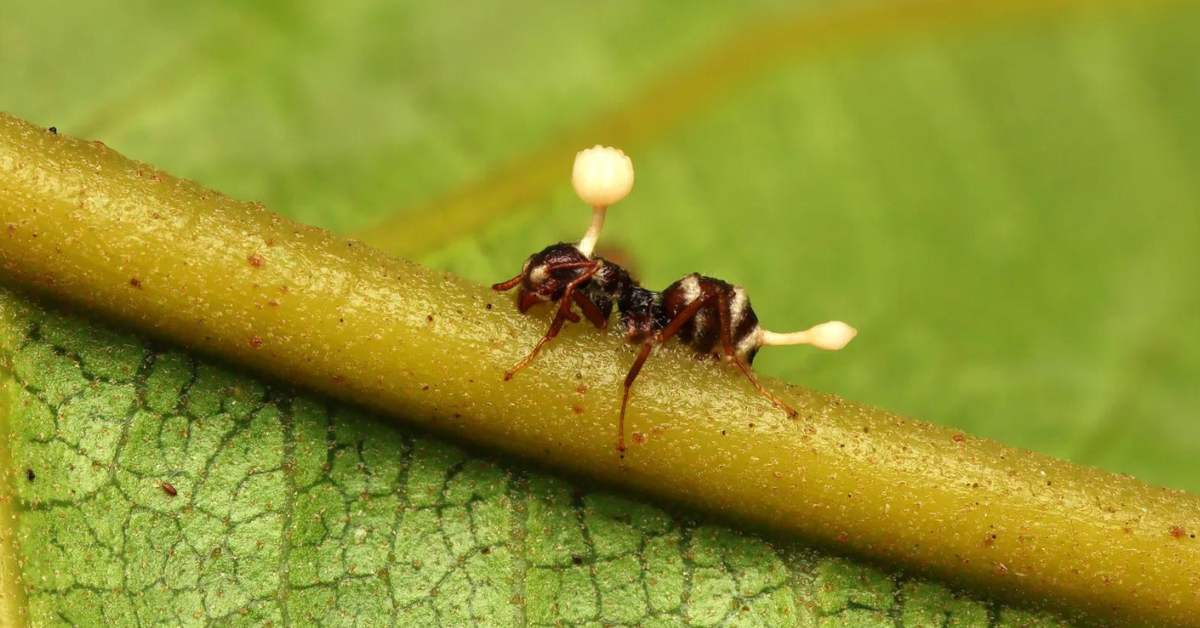Fungus is an understudied microorganism, but it captured attention after the HBO show “The Last of Us,” in which fungus took control over human bodies and turned them into zombies.
It was horrible to see this on the screen, but it turned into reality when the researchers found a zombie fungus responsible for turning ants into walking-dead organisms.
Ophiocordyceps unilateralis, a parasitic fungus, turns ants into zombies by spreading spores on foraging ants that penetrate into their exoskeleton. Spores manipulate their behavior by releasing neurotoxins and compel them to reach a height of 25cm on trees. They engage in a death grip by locking mandibles on leaves and die there within 6 hours. The fungal bloom emerges from its head and spreads spores to infect other colony members.
In 2020, Ian Will, Charissa de Bekker, and a few other researchers studied the zombie ant fungus by sequencing the DNA of fungal stalk by collecting it from the dead ant’s head. It helped them understand the genetics of this mind-controlling organism.
What parasitic fungus turns ants into deadly zombies?
A biology professor, Bryn Dentinger, who worked as curator of mycology in the Museum at the University of Utah, told people about the parasitic nature of zombie fungus.
In January 2023, he talked about the parasitic fungus that can turn ants into zombies through the National Public Radio platform. He differentiated this mind-controlling fungus from the one portrayed in the HBO show.
This zombie fungus is known as Ophiocordyceps unilateralis which captured the attention of researchers when dead ants with fungal blooms were discovered in tropical forests.
Dentinger also explained that human bodies do not provide the ideal temperature for their growth. So, it is unlikely for it to infect humans, and it invades only a few species of insects.
In 2019, Jennifer Lu discussed these parasitic fungi on the National Geographic Channel and said that they grow on ants’ bodies, get nutrition, and ultimately cause death.
Furthermore, it is not deadly enough, as shown in the HBO TV show, but it is lethal for a few species of ants found in the forests, particularly in areas with high humidity or plenty of sunlight.
How does parasitic fungus turn ants into zombies?
Many researchers and biologists at Oregon State University identified zombie fungus and studied its behavior in detail to understand its mode of action.
David Hughes, an experienced entomologist at Pennsylvania State University, studied and compared this fungus with the one in The Last of Us and found many similarities.
A microbiologist from Utrecht University, Dr. Chariassa de Bekker, also observed the behavior of Cordyceps fungi and its method of making ants zombies.
She showed concerns about the risk of infection in humans but got reasons to nullify her concept later. She found that humans have different nervous systems and endothermic bodies, unlike ants.
Spores infection
The Ophiocordyceps unilateralis is commonly present in Brazilian forests, Amazon rainforests, and tropical forests in different countries.
In 2017, Ed Yong mentioned the invasion mode of zombie fungus in The Atlantic and explained the infection method in carpenter ants and how it hijacks their body and mind.
The fungal spores infect the host bodies when the foraging ants visit the infected forest floor, searching for food particles and organic matter in the leaf litter.
Invasion
The fungal spores penetrate the bodies of the host organism and reach inside the host body after 1 to 2 days. It begins to grow inside the body, and hair-like growths extend inside it.
This way, it slowly expands in the body, but its growth and infection remain unnoticeable until it covers half of the body’s length. Ants remain busy in their colonies until the fungus begins to grow.
In addition, this invasion process is painful for them as they feel discomfort when the spores multiply and grow in their bodies.
Manipulation
After successful invasion and internal growth, this parasitic fungi begins to manipulate behavior. Rebeca Rosengaus said this parasitic fungus manipulates ants by changing their neurobiology.
She is an associate professor of marine and environmental sciences and studied that this parasitic organism produced neurotoxins or toxic chemicals to alter brain function.
These toxins compel infected ants to leave their colonies and move higher on the trees until they reach a height of 25cm, which is told by Ed Yong in The Atlantic in 2017.
The reason behind such manipulation and enforcement to reach such height is the need for ideal humidity and sunlight exposure that are favorable for fungal growth.
Death grip
In 2009, Carl Zimmer mentioned the death grip of O. unilateralis infected ants on the leaf in The New York Times. He said that the infected host used mandibles to bite the leaf and lock their jaws to maintain a grip and avoid movement.
This is called death grip because Cordyceps-infected ants die in this position within 6 hours of immobility. It hijacks the body and mind and causes parasitism in them.
Fungal growth
The Cordyceps grows on the dead ant and emerges from its head region, which serves as a Launchpad. It controls the muscle’s movement and blooms out of the head.
Moreover, a long stalk appears on the corpses after two days and grows outward as a bulb. This bulbous capsule produces toxic spores after 3 to 4 weeks of emergence.
This way, the lifecycle of parasitic fungus continues when the spores attach and penetrate the next host present under the tree and turn them into zombies.
Related Articles:


